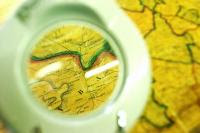 The Unprotected Battlefield: Conservationists Fight ot Prevent Development o9f Privately Owned Land With The National Park, T. W. Burger, The Harrisburg Patriot-News,May 21, 2008
The Unprotected Battlefield: Conservationists Fight ot Prevent Development o9f Privately Owned Land With The National Park, T. W. Burger, The Harrisburg Patriot-News,May 21, 2008 The town is famous because it was under fire in 1863. Gettysburg National Military Park, with 6,000 acres of Civil War battleground, continues to be under assault. More than a year ago, it was the threat of a slots casino being built nearby. A few months after that plan was snuffed, someone else suggested building an amusement park four miles away. Now, sights are on the private land within the park.
A study done this year shows that 1,054 acres -- one out of every five acres in the park's boundary -- are unprotected from development. The nonprofit group that operates the Gettysburg visitors center bought an 80-acre farm this month within the boundary and donated it to the National Park Service. The George Spangler Farm was in the middle of the Union line during the three-day Battle of Gettysburg in July 1863. It was used as an artillery and ammunition support facility and field hospital. The Gettysburg Foundation paid owners Ronald, Richard and Clarence Andrew $1.9 million for the farm.
Gettysburg National Military Park Superintendent John A. Latschar called the purchase an important step in protecting the battlefield. But in early April, the National Parks Conservation Association released the first comprehensive look in decades at development threats to land within national parks. The report highlights 55 parks and included a case study on Gettysburg National Military Park.
The National Park Service estimated that the Gettysburg park's top acquisition priorities are 119 acres of private property within its boundary that are for sale for about $3.6 million. While a March poll performed by Peter Hart Research Associates said 77 percent of voters think the federal government should protect national parks by buying private land within them, the work is being done, at least in Gettysburg, by individuals and nonprofit groups.
Dean Shultz, 69, owner of Gettysburg Engineering, owns a stone pre-Civil War house on the banks of Rock Creek. It was used as a field hospital during the war and has bloodstains on its floor planks to prove it. Shultz is a co-founder of the Adams County Land Conservancy, which, with other organizations, has preserved more than 500 acres in and around the battlefield. Shultz and his wife, Judy, own 100 acres of battlefield ground. He said the property will be protected but didn't want to discuss details.
His company office is on battlefield ground, and it's portable. "It's a mobile home, and when I don't need it anymore, it will be hauled away and the ground returned to the deer," he said. Shultz said most people assume that private land within the park is automatically safe from development. But "these inholdings are privately owned, and they can be developed in any way that the local municipalities permit," he said.
The Gettysburg park spreads across five municipalities, with a wide range of zoning. Its boundary was established in 1990. The National Park Service has a policy not to use eminent domain to take private property, even within that boundary. "On that basis, no municipality can turn down a project just because it's within the boundary. That's why those inholdings are not protected," Shultz said. The preferred method of dealing with the private land is for the park service to purchase the development rights -- easements -- if only because that is less expensive than purchasing the properties outright, park service spokeswoman Katie Lawhon said.
Lawhon said she could not say exactly how many, or even if any, properties were in process of sale or easements. The good news is the park service frequently gets calls from property owners who would like to sell. The bad news is that there's nothing in the piggy bank, Lawhon said. "We've had no money for the past several years," she said.
The last time Congress put anything into the park service's pocket for land acquisition at Gettysburg was in 2001. The proposed federal budget for 2009 has $2.2 million, but that's not in the bag, Lawhon said.
T.W. BURGER: 255-4123 or tburger@patriot-news.com
Text Source:
http://nl.newsbank.com/nl-search/we/Archives?p_action=doc&p_docid=120D227276FD1E30&p_docnum=3
Photo of Dean Schultz by Chris Marks gburginfo.brinkster.net/.../Muster2005Photos.htm








